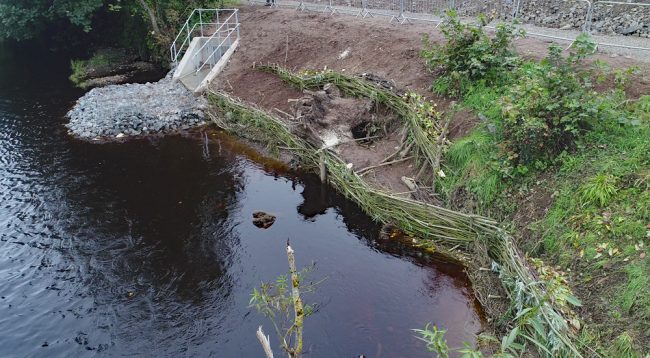We are keeping a close eye on how the willow spiling we installed at Tarholm on the Ayr is developing since we completed this work just under 1 month ago. It is incredible to see how much silt is being deposited with each spate. The photos below illustrate the change we’ve seen over the last weekend and since completion.

Look closely at the horizontal poles in this image taken on Friday and then compare them with the similar image below. It is incredible that a single spate can lead to so much deposition

High water on Sunday afternoon covered the lower terrace. The river was beginning to clear and drop by this point.

Despite the strong flows the weaving is holding well (as expected).
We revisited this site today after the weekend’s high water. It gave us a chance to compare the changes that have taken place over the weekend. What? As quick as that?… I almost hear people ask, and the answer is yes. Struan too the photos above on Friday and Sunday. I took those below this afternoon.

Compare the first photo Struan took on Friday with this one from today. In 3 days, there’s been a centimetre or two deposited across this area. Look at the horizontal stake nearest the camera then compare this to the top picture from Friday in which this same stake was completely exposed. This silt is deposited from the river and is building the bank behind the spiling.

A closer look at the horizontal stakes behind the face of the spiling. More sediment has deposited since Friday. Compare this to the overhead image below, that we took on the day of completion at the end of September.

The area marked with arrows was as it was left on completion. It is clear to see how effective brash and willow can be at trapping suspended solids. This build up has taken less than 1 month!

Another view of the site on the day of completion.
It is good to see brash bundles filled with sediment and the hollow behind the willow is steadily filling with every spate. What is most concerning is the sediment load this river carries with every lift in levels. It’s no wonder the harbour master was complaining to us of the increasing frequency they are required to dredge Ayr Harbour in recent years. He has offered us his data and I’m keen to see it when I can.


Ok its very clear to see that bank errosion with high levels of silt is occuring in all parts of the ayr coupled to the fact of serious cattle fowling, this whole river needs cleaned up and solutions found, so what are you going to do about that.
Vincent Honeyman, I’m going to ask you why you think we should do anything? Is this not a Landowner, SEPA and a Board responsibility? Of course our answer is deliberately simplistic but I will clarify for all… ART are a charity with limited funding and we perform green bank engineering wherever we can and where our limited funds allow. Bear in mind we generally receive no funding from Government or DSFB’s for this. Why do we do this? We do this to demonstrate how effective these methods are and to and encourage others, particularly to landowners, to take action and show what can be easily achieved if people are willing to maintain their own patches. This is a highly effective and relatively cheap method of erosion control (free if you have time and can source the materials) and it is a far better environmental and ecologically friendly solution than opting for expensive and unnatural armour rock or similar. Wherever we can secure funds to allow other areas to be addressed, we will but unless we recoup our costs, we won’t survive to show others how they can make a difference. I hope that answers your question. If you want more than that, I’d suggest that you contact your DSFB and ask them to allocate funding for these and many other important works. ART can’t be a scapegoat for years of failings by others. These problems have been around for decades and only now has anyone thought to tackle them.
Fair Play